Just like a cyst anywhere else in your body, a cyst in the brain is a sphere filled with fluid—much like a balloon filled with water. They may contain fluid, blood, tissue, pus, or tumor cells. Brain cysts are not truly “brain tumors” because they do not arise from the brain tissue itself.
Although they tend to be benign (non-cancerous), they are sometimes found in parts of the brain that control vital functions. Many cysts are formed before birth and slowly grow over the course of years. Some arise as a result of head injury or infection.
There are five main types of cysts found in the brain: Arachnoid, Colloid, Dermoid, Epidermoid, and Pineal. Cysts are diagnosed through use of imaging tests such as CT or MRI.
Location
Cysts can appear in a variety of locations within the brain.
- Arachnoid Cysts appear in the tissue that surrounds the brain, called the meninges. They also occur in the space between the arachnoid and pia mater layers of the meninges. Most are located near a part of the brain called the lateral sulcus (aka Sylvian fissure), middle fossa, suprasellar area near the third ventricle, and the lower back part of the brain (posterior fossa).
- Colloid Cysts can be found in many parts of the brain but are typically near the third ventricle and the foramen of Monroe.
- Dermoid Cysts, though rarely found in the brain, are usually located at the lower back portion of the brain (the posterior fossa) in older adults and in the lower end of the spine in older children and young adults. They appear as tumor-like spheres.
- Epidermoid Cysts tend to be located in the area where the top part of the brain meets the brain stem. They can also grow on or near cranial nerves.
- Pineal Cysts are located on or near the pineal gland.
Symptoms
Symptoms depend on the size and location of the cyst and can vary from person to person.
- Arachnoid cysts typically cause headaches, seizures, changes in vision and hearing, nausea and vomiting, dizziness, hydrocephalus, focal symptoms, and cranial nerve symptoms.
- Headaches and seizures are common symptoms with dermoid cysts.
- Colloid cysts can lead to headaches, nausea, vision changes, cognitive impairment, vertigo, and vomiting caused by increased intracranial pressure or hydrocephalus.
- Symptoms of epidermoid cysts include headaches, hearing loss, ringing in the ears, face twitching, or facial pain (trigeminal neuralgia).
- Pineal cysts can cause headaches, hydrocephalus, motor and sensory disturbances, seizures, vertigo, changes in vision, and hemiparesis.
Treatment
The type, size, and location of the cyst determine how it will be addressed. Treatment methods for the various types of cysts are briefly explained below:
- Arachnoid Cyst: Treatment may be “watchful waiting,” or the cyst may require surgery. A shunt may be used to treat hydrocephalus by draining the excess cerebral spinal fluid (CSF).
- Colloid Cyst: Surgery is typically recommended. However, removal can be challenging due to location. A shunt may be used to treat fluid build-up caused by hydrocephalus.
- Dermoid and Epidermoid Cysts: Surgery is typically recommended. If complete removal is not possible, the remaining portion of the cyst may regrow. Fortunately, this growth may be very slow and it could be years before symptoms return.
- Pineal Cyst: Surgery is an option for pineal cysts causing symptoms. Because the pineal gland can be difficult to reach, minimally invasive or endoscopic surgery may be performed. Recurrent pineal cysts may be treated with brachytherapy.
Prognosis
Incidence
- Arachnoid cysts make up about 1 percent of all intracranial (brain) masses. Since most cysts do not cause any symptoms, the exact incidence rate is unknown. They are the most common brain cyst. They occur in males more often than females.
- Colloid cysts make up less than 2 percent of all primary brain masses.
- Although they can occur at any age, Epidermoid cysts are believed to form during the earliest stages of development (embryo) and are most commonly diagnosed in middle age.
- Pineal cysts account for about 1% of all intracranial (brain) masses and are discovered most commonly in women aged 15-49.
Age Distribution
- Arachnoid Cysts can be found in both adults and children.
- Colloid Cysts typically occur in adults.
- Dermoid Cysts in the brain tend to occur in children under 10 years old.
- Epidermoid Cysts are most commonly found in middle-aged adults.
- Pineal Cysts are found in people of all ages, but most commonly in adulthood.
Risk Factors
Molecular Profile
Molecular profiling is the detection of specific genes, proteins, or other molecules in a tumor. This information helps confirm tumor diagnosis, inform treatment options, and predict prognosis.
There are no known molecular markers for cysts.
Additional Resources
Content last reviewed:
April 2022 by Mary Ann Laubacher, MSN, RN




